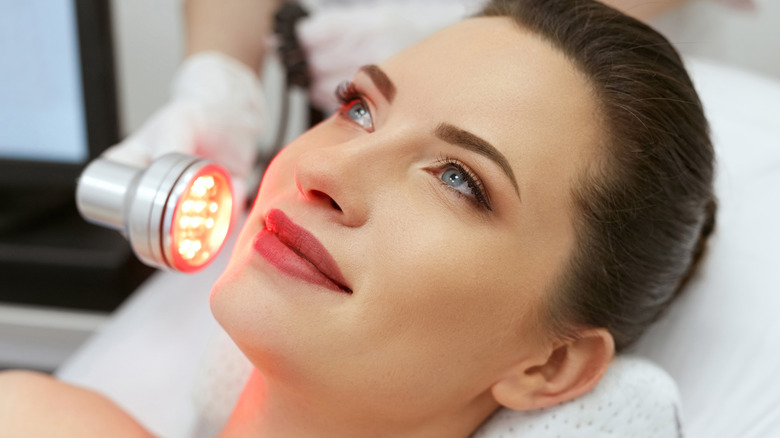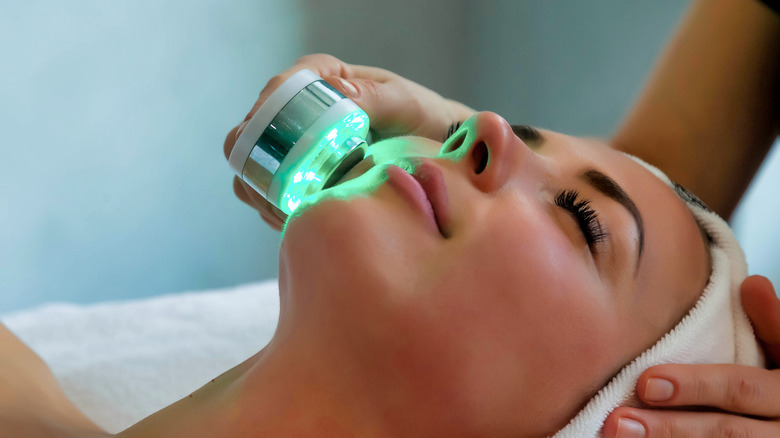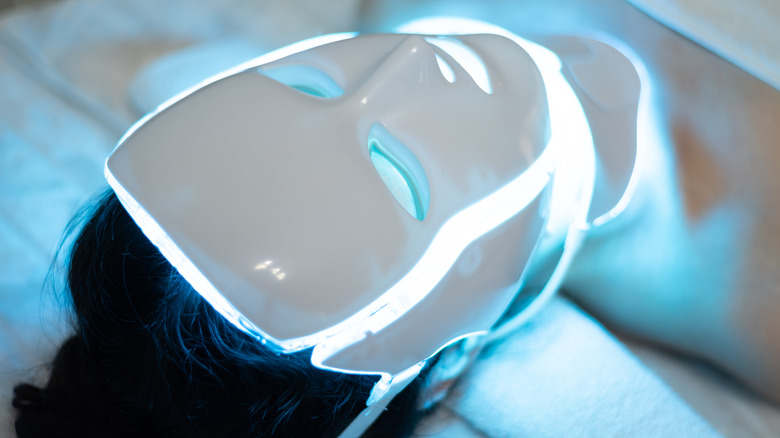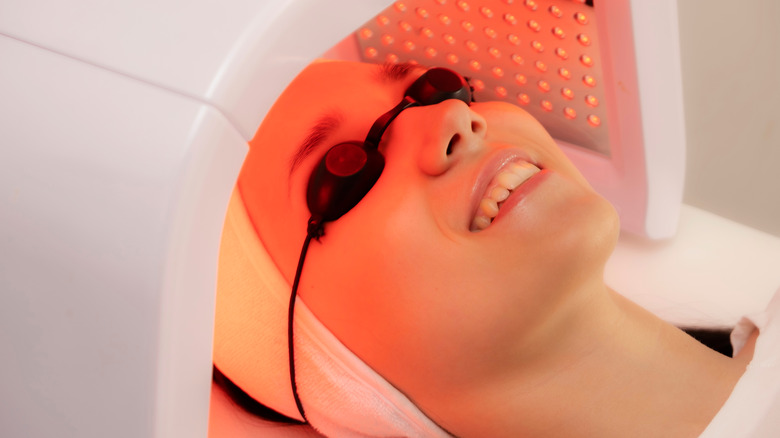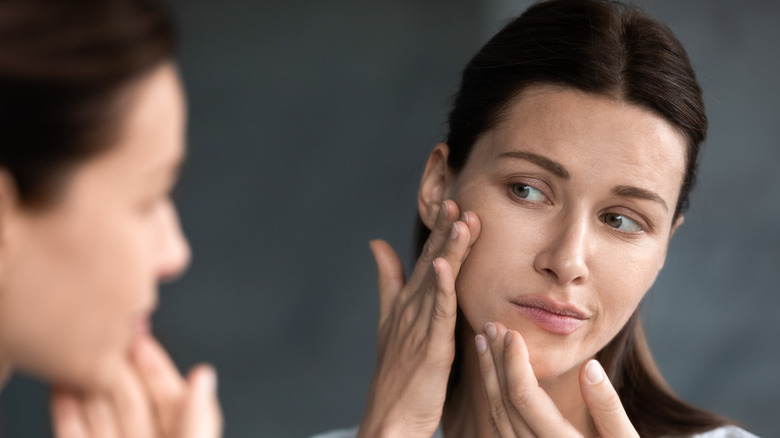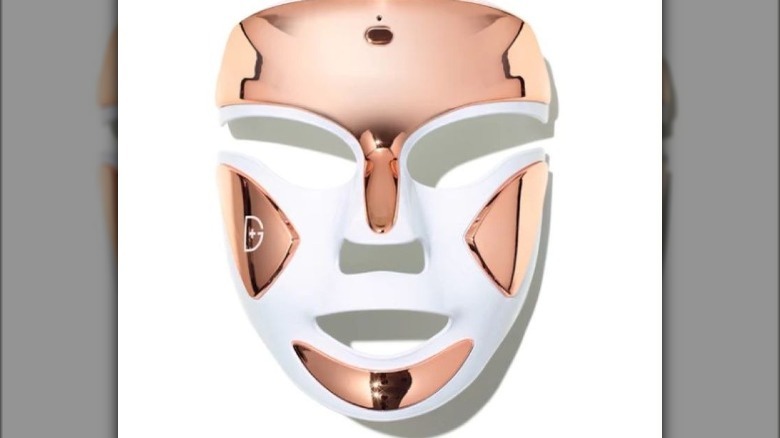Everything You Need To Know Before You Do LED Light Therapy For Your Skin
We may receive a commission on purchases made from links.
Have you noticed more fine lines around your eyes and forehead when you look at yourself in the mirror? Do you see some subtle sagging around the jawline? Those are all signs of aging, and our never-ending quest to hold on to eternal youth has us investing in expensive creams and in-office treatments like microneedling. A little trip to the dermatologist can be pricey, and nowadays, at-home skincare tools promise younger and touter skin from the comforts of your own home.
In fact, one popular option is the NuFACE Facial Toning Device. Francesca Fusco, M.D., an assistant clinical professor of dermatology at Mount Sinai in New York City, tells Glamour, "Microcurrent units stimulate muscles and tighten skin, giving a lifting effect to brows, eyes, jawline, cheeks, and neck," adding that it helps stimulate collagen production and heal wounds.
If you're a beauty fanatic, though, you might've seen futuristic, sci-fi-looking masks all over Instagram that promise you dermatological results at home. That's LED light therapy for you. In fact, LED stands for light-emitting diode, with board-certified dermatologist Dendy Engelman telling Byrdie, "It works by emitting infrared lights (causing heat) in different wavelengths/spectrums, which have different skincare benefits." In a way, LED light therapy is similar to other at-home skincare options, but it's unique nonetheless. Ready to learn more?
What is LED light therapy?
You'd think LED light therapy was invented for younger-looking, smoother skin. However, it was originally used by NASA to help astronauts repair their wounds with its regenerative benefits in the 1990s (via the Cleveland Clinic). It's a non-invasive treatment where the light of different wavelengths goes deep into the skin to improve skin conditions like sun damage and wrinkles, heal wounds, and even help with hair loss.
According to the American Society of Plastic Surgeons, LED light therapy is commonly used in skincare for its antiaging and inflammation-reducing benefits. It works by stimulating collagen production that can help diminish the appearance of fine lines and wrinkles and gives you a smoother and firmer complexion. LED light therapy also has anti-inflammatory benefits and can help with acne, dermatitis, and eczema. At times, it can help a common type of superficial skin cancer called basal cell carcinoma (BCC), which affects about 3.6 million people nationwide.
On this, Jessica Weiser, M.D., a dermatologist at New York Dermatology Group, tells Glamour, "The science behind this device is legitimate, and these types of light therapy are offered in many dermatology practices, including my own." She adds that a great benefit of this procedure is that it works on all skin types and tones. This FDA-approved treatment is also safe to use during pregnancy and breastfeeding, which is excellent because many skincare ingredients are on a strict no-no list to use during those times.
Different colored LED lights have various skin benefits
Different colored lights represent different wavelengths, penetrating the skin at different levels. Depending on the color of the light, they work on various skin conditions. According to the Cleveland Clinic, blue light works on the top layer of the skin, yellow light goes a little deeper than blue light, red light penetrates deeper than both blue and yellow lights, and near-infrared goes the furthest deep into the skin.
Amber (or yellow) light helps increase collagen and elastin production. Meanwhile, red LED lights work to improve blood circulation, and white light, which digs deeper than other colors, helps to lessen inflammation on your face, aw Dendy Engelman, a board-certified dermatologic surgeon, tells Byrdie.
Each color activates a different cellular reaction based on your needs to repair and rejuvenate your skin. In fact, Dr. Joshua Zeichner tells Glamour, "Red light has anti-inflammatory properties, while blue light helps lower levels of acne-causing bacteria on your skin." Blue light can also help with cystic acne. Dermatologist Jessica Weiser adds that red light also helps increase collagen in our skin and often has amber lights that help with sun damage. Ultimately, you can choose the color based on your skin condition and needs.
How to get the best results from LED light therapy
Using LED therapy to combat signs of aging, acne, or inflammation might sound pretty simple, but there are things you need to do before and after the procedure. You can get it done at an office or at home with an LED light therapy mask. Moreover, it's done on clean skin without any products so the light can efficiently penetrate the skin (via the Cleveland Clinic).
If you're getting it done in-office, speak with the physician about preparing for your appointment. "Eye protection is also placed as the lights are quite bright. We treat [the skin] for about 15 to 20 minutes. At first, it feels warm, but patients report liking the feeling" as the LED device is put close to the face," plastic surgeon Sheila Nazarian tells Byrdie. Regarding getting the treatment in-office versus at home, she adds, "Both are good. But you're not going to get as intense of a treatment at home."
You might want to run out into the world to show off your beautiful skin after the treatment, but Dr. Nina Bal recommends avoiding the sun for 48 hours and wearing SPF religiously, per Elle. 'You can take an anti-inflammatory in case of swelling and redness (rarely needed), or apply cold packs," Dr. Bal explains. Though you will notice results after one use, skincare expert Natali Kelly recommends using it a minimum of six times and up to 12 times for a little extra help.
Who shouldn't try LED light therapy
While the promises of this FDA-approved device are evidence-based and the treatment itself is non-invasive, you might want to try it ASAP. However, it's not the best for everyone. Its ability to repair and rejuvenate damaged skin might seem too tempting, but specific populations aren't the right candidate for LED light therapy. According to the Cleveland Clinic, you shouldn't try LED light therapy if you have inherited eye diseases or genetic disposition for specific health conditions like skin cancer. They also don't recommend it for people who are on lithium.
If you're taking any photosensitizing medicines that make you more sensitive to the sun, like certain antibiotics or isotretinoin (acne medication), you shouldn't try LED light therapy, per WebMD. According to Healthline and the American Society of Plastic Surgeons, people taking acne medication like Accutane or those with pre-existing skin rashes should skip this as it might worsen their skin conditions. Consult your dermatologist or physician to ensure it's the right treatment for you.
Side effects of LED light therapy
Generally, LED light therapy is safe to use and doesn't negatively affect your skin, but there is always the possibility of side effects based on your skin type or the device. According to WebMD, the procedure has fewer side effects than laser therapy, but some people might experience redness, swelling, itching, or dryness on their skin. It's also necessary to keep your eyes protected when using this, as certain medications can make your eyes more sensitive to light, and you wouldn't want it to hurt them.
Though the potential side effects are rare, it's possible that skin exposed to LED light therapy might experience increased inflammation, rash, or pain, per the Cleveland Clinic. The clinic also adds that it's considered safe for short-term use but needs more research on how it affects your skin if you use it more long-term. If you have second thoughts regarding the side effects, check with your physician or dermatologist before trying the in-office or at-home LED device. You wouldn't want to choose a treatment for more beautiful skin to leave prone to more skin issues.
The cost of LED light therapy
You can get LED light therapy treatment on its own or add it to another in-office treatment like microneedling and microdermabrasion, but the costs can vary. According to Healthline, one LED light therapy session at the dermatologist's office or the spa can cost you anywhere between $25 to $85 or more, depending on the practitioner, the location, and whether or not you're getting it in conjunction with another treatment. You have to remember that one session isn't enough, and your practitioner can recommend multiple sessions, making the cost add up. Do your research and read reviews to find the best spot to get the treatment within your budget.
On the contrary, at-home devices can be cheaper, with a one-time cost ranging between $25 and $250 on average (via Healthline). We love the Dr. Dennis Gross Skincare's DRx SpectraLite FaceWare Pro, which combines red and blue light modes to help with wrinkles and blemishes, and you only need to use it for three minutes a day. It has over 37 thousand likes on Sephora, with a reviewer saying, "I've had my mask for a few years, and I can't live without it! The biggest improvement is that it's really firmed up my jawline and the sagging in my jowls."
